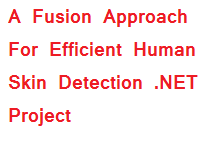ABSTRACT:
A solid human skin discovery technique that is adjusted readily to various human skin hues and light conditions is fundamental for better human skin division. Despite the fact that diverse human skin-shading location arrangements have been effectively connected, they are inclined to false skin recognition and are not ready to adapt to the assortment of human skin hues crosswise over various ethnic. Besides, existing strategies require a high computational cost. In this paper, we propose a novel human skin recognition approach that consolidates a smoothed 2-D histogram and Gaussian model, for programmed human skin location in shading image(s). In our approach, an eye identifier is utilized to refine the skin demonstrate for a particular individual. The proposed approach diminishes computational expenses as no preparation is required, and it enhances the precision of skin recognition regardless of wide variety in ethnicity and enlightenment. To the best of our insight, this is the main technique to utilize combination procedure for this reason. Subjective and quantitative outcomes on three standard open datasets and a correlation with cutting-edge strategies have demonstrated the viability and vigorousness of the proposed approach.
SYSTEM ANALYSIS:
PROBLEM DEFINITION:
A dependable human skin recognition technique that is adjusted readily to various human skin hues and enlightenment conditions is basic for better human skin division.
The existing strategies require a high computational cost. In this paper, we propose a novel human skin discovery approach that joins a smoothed 2-D histogram and Gaussian model, for programmed human skin recognition in shading image(s).
In our approach, an eye finder is utilized to refine the skin show for a particular individual. The proposed approach lessens computational expenses as no preparation is required, and it enhances the precision of skin identification in spite of wide variety in ethnicity and brightening.
The first technique to utilize combination system for this reason. Subjective and quantitative outcomes on three standard open datasets and a correlation with best in class strategies have demonstrated the adequacy and vigorousness of the proposed approach.
Because The picture pixels portrayal in a reasonable shading space is the essential advance in skin division in shading pictures. A superior study of various shading spaces for skin-shading portrayal and skin-pixel division techniques is given by Kakumanu et al.
EXISTING SYSTEM:
• The least difficult and regularly utilized human skin identification techniques is to characterize a settled choice limit for various shading space segments. Single or numerous scopes of limit esteem for each shading space segments are characterized and the picture pixel esteems. This predefined range (s) are chosen as skin pixels.
• In this approach, for any given shading space, skin shading possesses a piece of such a space, which may be a reduced or huge district in the space. These previously mentioned arrangements that utilization single features, albeit, effectively connected to human skin location. Despite everything, they experience the ill effects of the accompanying.
(1) Low Accuracy: False skin identification is a typical issue when there is a wide assortment of skin hues crosswise over various ethnicity, complex foundations and high enlightenment in the image(s).
(2) Luminance-invariant space: Some strength might be accomplished by means of the utilization of luminance invariant shading space, be that as it may, such an approach can withstand just changes that skin-shading conveyance experiences inside a limited arrangement of conditions and furthermore debases the performance.
(3) Require huge preparing test: keeping in mind the end goal to characterize edge value(s) for recognizing human skin, the greater part of the cutting edge work requires a preparation organize. One should understand that there are tradeoffs between the span of the preparation set and classifier execution.
LIMITATIONS OF EXISTING SYSTEM:
• The existing strategies require high computational cost, and not presented in the 2-D histogram techniques.
PROPOSED SYSTEM:
• The proposed approach lessens computational expenses as no preparation is required, and it enhances the precision of skin location in spite of wide variety in ethnicity and enlightenment.
• To the best of our insight, this is the principal technique to utilize combination system for this reason. Subjective and quantitative outcomes on three standard open datasets and an examination with cutting-edge strategies have demonstrated the viability and hearty ness of the proposed approach.
• A 2-D histogram with smoothed densities and a Gaussian model are utilized to demonstrate the skin and nonskin disseminations, separately. At long last, a combination methodology structure utilizing the result of two highlights is utilized to perform programmed skin recognition.
• The proposed system for programmed skin recognition. Initial, an approach like that of Fusel et al. Second, a dynamic technique is utilized to ascertain the skin limit value(s) on the identified face(s) area. Third, two highlights the 2-D histogram with smoothed densities and Gaussian models are acquainted with speak to the skin and non-skin circulations, separately. At last, a combination system that uses the item lead on the two highlights is utilized to acquire better skin discovery comes about. In this paper, the RGB shading space is changed over to the LO space to copy visual human recognition.
PROPOSED SYSTEM:
The proposed approach lessens computational expenses as no preparation is required, and it enhances the exactness of skin location regardless of wide variety in ethnicity and brightening. The proposed technique has two preferences in contrast with the best in class arrangements. (1) Our proposed skin recognition technique utilizes an online dynamic limit approach. With this, a preparation stage can be wiped out. (2) We select a combination methodology for our skin indicator. To the best of our insight, this is the main endeavor
That utilizes a combination technique to identify skin in shading pictures.
DOWNLOAD PROJECT DOC: A Fusion Approach for Efficient Human Skin Detection



